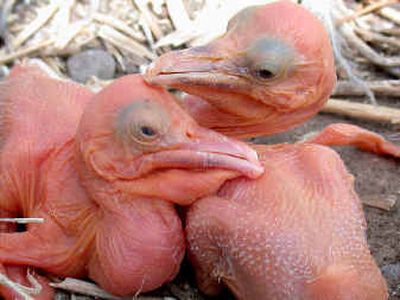Prospering pelican population poses problems

HELENA — In 1991, new arrivals to the Canyon Ferry Wildlife Management Area started making a few nests on the islands at the south end of the reservoir. Within 14 years, the pelican nests at Canyon Ferry have gone from 13 “novelties” to more than 2,000 nests.
Each spring, Montana Fish, Wildlife and Parks wildlife biologist Tom Carlsen hops in a boat and motors from island to island in the ponds at the south end of Canyon Ferry and counts the number of pelican, cormorant, and other bird nests.
“The pelicans started off with 13 nests in 1989 and it was kind of unique,” said Carlsen. “Then, at 100 nests it was kinda neat. Now, it’s just a problem.”
The problem is multifaceted. The four ponds at the south end of Canyon Ferry were created to provide secure nesting sites for ducks and geese. Waterfowl have used the island nest sites for years with minimal impact to the vegetation on the islands.
Pelicans, however, are colony nesters and the sheer number of birds per island results in the pelicans trampling each island’s vegetation into mulch.
After denuding an island, the pelicans will move onto a different island and trample the plant life there, too.
“The management plan dedicated islands to colony nesters (such as pelicans and sea gulls), but they keep moving around,” Carlsen said. “Once pelicans get rid of all the vegetation on an island it becomes almost worthless as a nesting site for waterfowl.”
Also nesting on the islands with the pelicans, although in far fewer numbers, are two species of seagulls — California and ring-billed — and cormorants. Carlsen said he has witnessed gulls preying on ducklings, but that the goslings are too big and too well defended by their parents to be seagull food.
Many anglers are not fond of pelicans. Pelicans eat fish, and lots of them. Some anglers have blamed the number of pelicans and cormorants for declining numbers of trout and other fish species in Canyon Ferry.
Studies conducted by FWP and other fish and game agencies around the country indicate that pelicans consume fish at or near the surface of the water. On Canyon Ferry that means pelicans consume mostly rough fish such as carp and suckers.
Cormorants, on the other hand, are deep divers and take a lot of trout and other species inaccessible to pelicans. Although the 838 pairs of nesting cormorants in 2003 represent a considerable threat to game fish, cormorants are less destructive to vegetation while nesting than pelicans. Cormorants build elevated nests of sticks and return to them year after year.
Both pelicans and cormorants are federally protected. In a few states where cormorants have severely hit fish populations, federal agencies have allowed control measures to keep cormorant populations in check. So far, however, controlling pelican populations has been taboo.
“U.S. Fish and Wildlife Service has allowed some very limited control in the Southeast and South primarily in relation to fish farms,” said biologist Rob Hazlewood of the Fish and Wildlife Service. “Under certain circumstances, when it’s a commercial operation people are making their living from, we’ve allowed it.”
Hazlewood said he’s aware of the issues involved with the pelicans and cormorants on Canyon Ferry, but believes more study is needed.
“There would need to be better documentation before I even would want to bring the word (control) up. Most bird populations don’t continue to grow exponentially,” Hazlewood said. “Those populations usually find a way to regulate themselves.”
Carlsen agreed with Hazlewood that more documentation is needed before any action is proposed.
“Pelicans are a neat bird but if keeps going the way it has, we’ll wind up with the world’s largest pelican population and that’s not our goal here,” Carlsen said. “Anything we do eventually do here will be based on good science. I insist on that.”